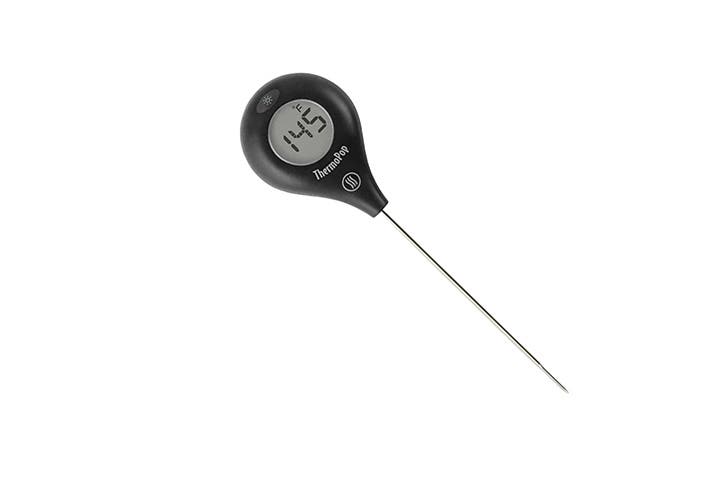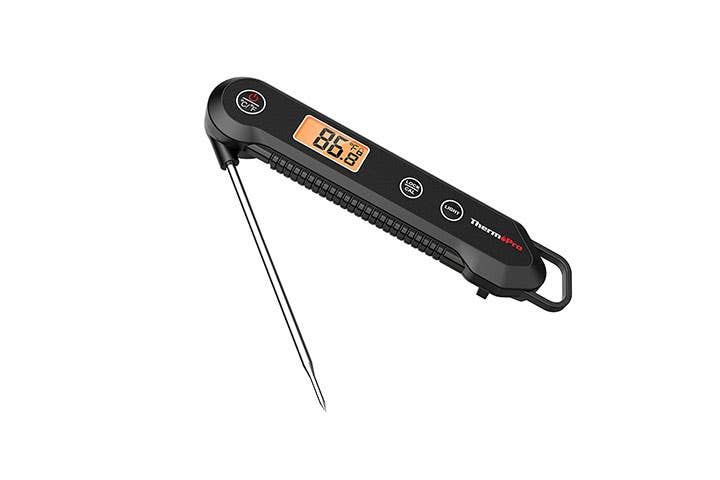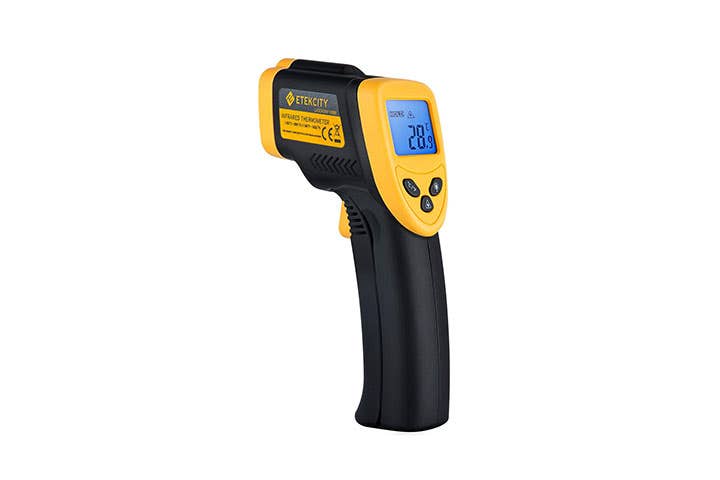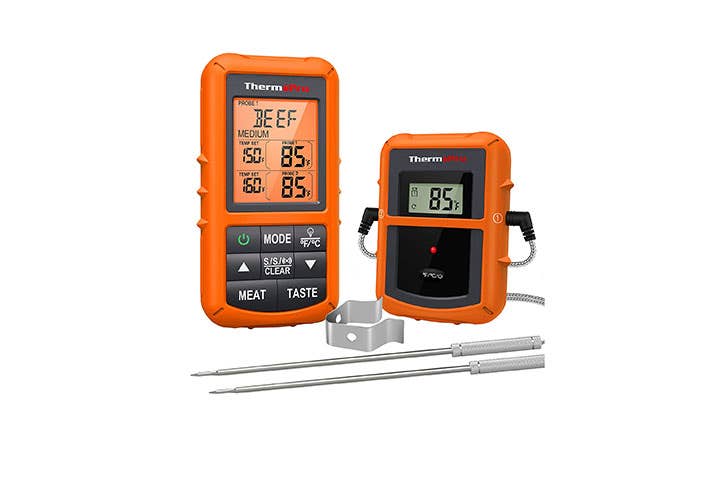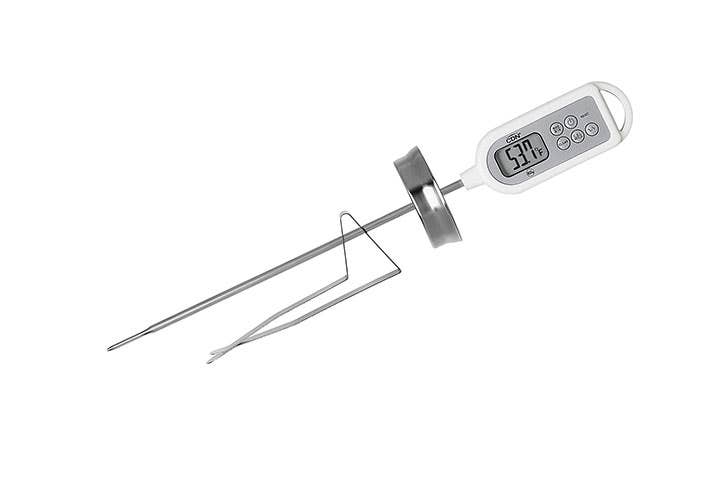The Best Grill Thermometers Make Great Steaks
Use the right grill thermometer to ensure your meat is cooked to perfection every time.
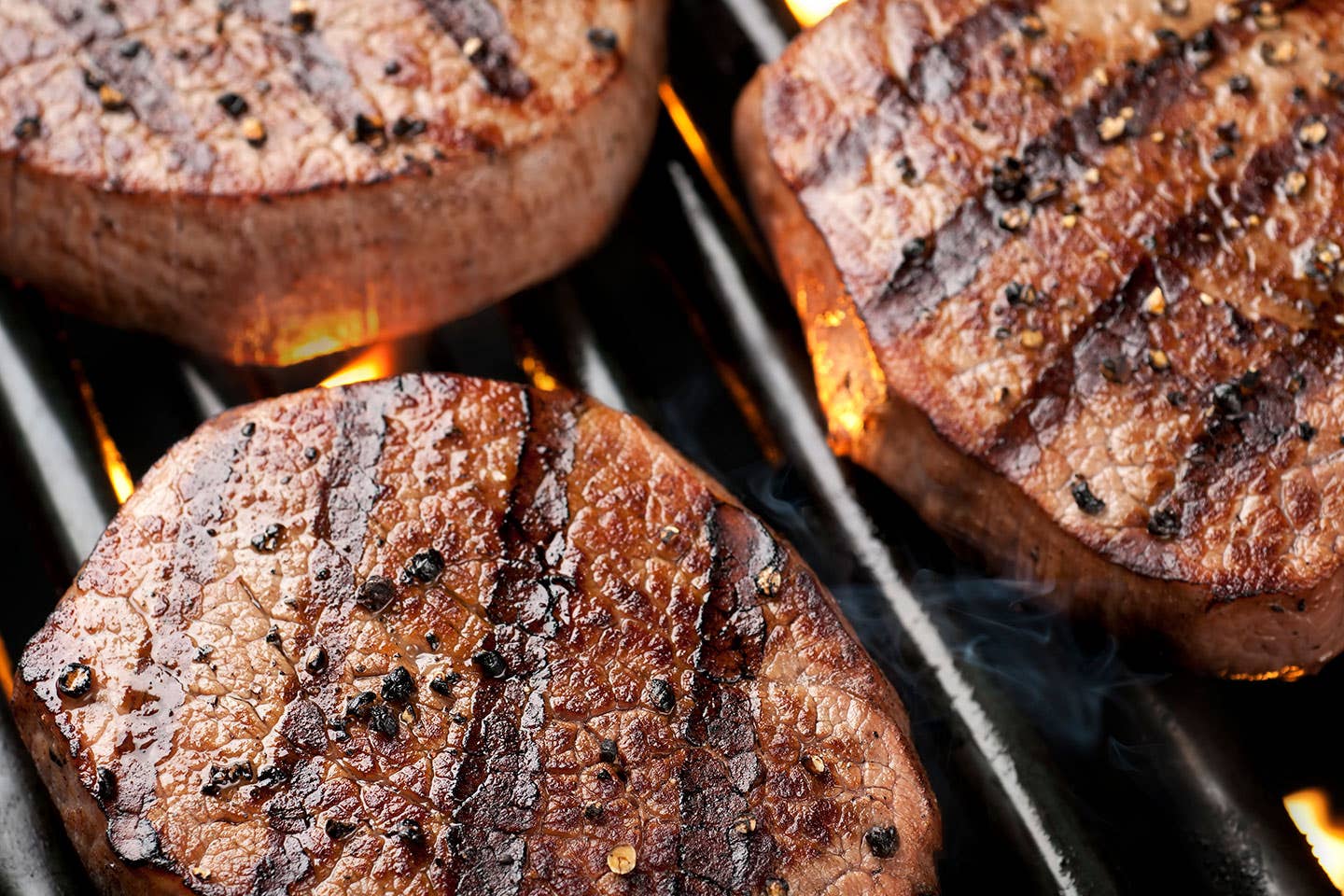
Whether you’re a beginning cook who loves grilling as a hobby or a professional chef, if you don’t have an accurate grill thermometer, you could make critical errors in the safety and taste of your food. If you don’t know what temperature your meat should be at before it goes on the grill and during cooking, you’re going to have problems with both safety and taste. For instance, chicken should reach an internal temperature of 165°F and pork should be cooked until it reaches 145 degrees, according to the FDA. A rare steak should reach a minimum internal temperature of 145°F (though most chefs are looking for 125°F for rare).
We spoke with Craig Blondis, the co-founder and co-owner of Central Barbecue in Memphis, Tennessee, to learn why it's important to use thermometers while grilling. Blondis started in the competitive BBQ circuit and has years of experience making sure grilled meats get to the right temperature. “First and foremost, you’ll want to use a thermometer to make sure your meat is properly cooked,” says Blondis. “For example, when cooking chicken, if you know that it’s considered done at 165 degrees F, you’ll want to cook it to 165°F, and the only way to do that is to check the temperature of it." It’s important to know how long it takes for food to reach certain temperatures, especially if you want to avoid overcooking your protein. While seasoned cooks are often able to estimate doneness by touch, it’s still a good idea to double-check with a thermometer, and give your protein time to rest.
“If you want something that is medium-rare,” says Blondis, “you’ll want to pull it off when it’s at 120°F internal temp and let it rest so that it’ll cook the rest of the way. A thermometer will help you know when to do that.”
We also got the inside scoop in the category from two more expert sources who shared what they look for in this important grilling tool and offered advice for novice grillers: Amethyst Ganaway, a chef and writer who specializes in Southern and Lowcountry cuisine and chef Mareya Ibrahim, author of Eat Like You Give A Fork: The Real Dish on Eating to Thrive.
The best grill thermometers utilize accuracy, time, and technology at many price points to ensure that professional and home cooks can grill confidently with consistent results. So, if you’re looking to up your grilling game this summer, here are some of the best grill thermometers that will ensure your food comes out right every time.
The Best Grill Thermometers: Our Top Picks
- Best Overall: Thermoworks ThermoPop Digital Pocket Thermometer
- Best Value: ThermoPro TP03H Digital Instant Read Meat Thermometer
- Best Infrared: Etekcity Infrared Thermometer 1080, Digital Temperature Gun
- Best Multi-Probe: ThermoPro TP20 Wireless Meat Thermometer with Dual Meat Probe
- Best Long-Probe: CDN DTW450L Long Stem Waterproof Thermometer
Best Overall: Thermoworks ThermoPop Digital Pocket Thermometer
Best Overall
Maximum Temperature: 572°F | Number of Probes: 1 | Power Source: Lithium Coin Cell Battery
Pros
- Rotating display makes it easier to read the display from any angle
- Affordable price
- Waterproof and easy to clean
Cons
- Longer than instant read (3-4 seconds)
- Not dishwasher safe
Why we chose it: Flat and fast, this instant-read thermometer’s small size belies its capabilities.
For pitmasters, chefs, and grill enthusiasts, the Thermoworks ThermoPop thermometer is an instant classic and our top pick for best grill thermometer. The rotating temperature display and pocket-sized design offer grilling enthusiasts a broad range of display options and premium performance. The ThermoPop is made of stainless steel, and has a glass window with a piece of plastic that protects it from scratches; the clip on the back folds flat against the device when not in use and is spring-loaded, so you can easily store it nearby.
The ThermoPop is fast: In just three seconds, its accurate temperature readings can be seen on the screen and are guaranteed plus or minus 2°F. In addition, the auto shut-off feature activates after 10 minutes of inactivity, meaning you're not worrying about the battery going dead if you accidentally leave it on. Lastly, it comes in nine colors. So while fashion isn't a factor here, it certainly doesn’t hurt. If you’re looking for a reliable and accurate thermometer that shows price temperatures every time, the ThermoPop is an excellent choice.
Best Value
Maximum Temperature: 572°F | Number of Probes: 1 | Power Source: Battery
Pros
- Easy-to-read LCD screen
- Waterproof, making cleanup a breeze
- Lock function keeps temperature steady
Cons
- Display does not rotate
- Hand wash only
- No automatic shutoff
Why we chose it: This instant-read thermometer is a steal. While it does not have some the key features found on fancier models, its accuracy more than makes up for it.
The TP03H display is large and easy to see at a glance, a key feature when multitasking at the grill. The alarm feature is also a plus as it goes off when the meat has reached the right temperature. It is well made and durable; we love the fact it is waterproof, which makes it easy to wash and protected on a hot, humid day.
A couple of things to consider: while this model is waterproof, you can only wash it by hand, so don’t toss it in the dishwasher. The large LCD is a win, but it doesn’t rotate and reduces the versatility in how you use it. Lastly, not having an automatic shut-off means you need to keep on your toes and turn it off when it’s not in use. For the price and the features, this is a good buy for anyone who cooks outdoors.
Best Infrared: Etekcity Infrared Thermometer 1080, Digital Temperature Gun
Best Infrared
Maximum Temperature: 1022℉ | Number of Probes: 0 | Power Source: Battery
Pros
- Affordable price point
- High maximum temperature
- Built-in laser allows for added precision
Cons
- Does not read internal temperatures
- Short return policy
- Ambient temperature can affect a probe's readings.
Why we chose it: This compact, affordable infrared thermometer is a must-have for any home cook who wants to ensure their grill or oven is reaching the correct temperature.,
At the press of a button, you can instantly know the surface temperature of any grill area via its infrared laser. We love it because it’s easy to use and has a bright, clear display that reads temperatures Fahrenheit or Celsius. Additional features include a hold feature for continuous temperature readings and a backlight for taking measurements in dim light conditions. It has a range of 100 feet and a precision to 1/10th of one degree, which is accuracy we can get behind.
Best Multi-Probe: ThermoPro TP20 Wireless Meat Thermometer with Dual Meat Probe
Best Multi-Probe
Maximum Temperature: 572°F | Number of Probes: 2 | Power Source: AAA Batteries
Pros
- Both a countdown and count-up timer
- Monitor works up to 300 feet away
- Preset temperatures for nine different cuts of meat and poultry
Cons
- There’s a learning curve, keep those instructions close by
- No auto-lock on the temperature
- Not enough difference between the two probes
Why we chose it: This multi-probe thermometer has many features of more expensive models but at a more affordable price.
This highly accurate food thermometer checks the temperature of two different pieces of meat simultaneously. “When using a thermometer for grilling, keep in mind that the heat from the grill can affect the temperature reading [of the thermometer],” says chef Amethyst Ganaway. A dual probe thermometer will allow you to monitor both with ease, as you can use one probe for your meat, and the second to track your grill’s temperature. In addition, you can also use a dual probe to track the temperatures of two cuts of meat at the same time, ensuring that your large roast and your smaller chops will come to temperature at the right times.
One feature that really stands out is the preset temperatures for nine different cuts of meat and poultry. A great time-saving feature of the ThermoPro wireless thermometer is that you can set it to alert you when the desired temperature has been reached, so you don’t need to keep checking on your food. The auto shut off saves you from burning out the battery
However, we’d love to see an auto-lock feature on this model as that could only help with that "set it and and forget it" functionality. And while the wireless monitor gives us up to 300 feet range, the bulky size is a bit of a miss. Similar to the size of a cell phone, we’d love to see some sort of clip or ability to carry it around without having to stick another device in our pocket. That said, this thermometer is packed with features that allow you to get significantly more than what you pay for and is great for both professional and newbie chefs.
Best Long Probe: CDN DTW450L Long Stem Waterproof Thermometer
Best Long-Probe
Maximum Temperature: 450°F | Number of Probes: 1 | Power Source: CR2 battery
Pros
- Easy calibration, one-button setting
- Great for larger cuts of meat
- Dishwasher safe
Cons
- Slow speed, takes up to 6 seconds to read temperature
- Display can be a challenge to read
- No alarm setting
Why we chose it: Great for grilling a large cut of meat, this dishwasher-safe, long-stem thermometer maintains accuracy and quality at the hottest temperatures at an affordable price.
This unit comes in at an affordable price point and features a long-probe style, a favorite of Hussein, who has used this style for much of her career. “I find it the most effective because you can get into the center of the protein to get a doneness reading, and that’s the most accurate place to get a temperature.” A long stem is an excellent option for home cooks who want to keep their hands away from the grill’s heat. The added accessories of a heat shield and adjustable metal clip make this a solid purchase.
The DTW450L is a versatile, affordable option; it has a six-second read time, which is close to twice as long as the units featured above, so if you are looking for something that will give you super quick readings, this may not be the best option.
How We Chose These Products
There is a lot of information out there about the best thermometers. You can find them in a variety of styles and prices, and you need to know how each one works, and how you plan to use it, before buying one. After reviewing feedback from experts and customers, we selected five models based on price point, ease-of-use, and accuracy.
Features to Keep in Mind When Shopping for Grill Thermometers
Probe style
Probe-style grill thermometers are the most common type when it comes to grills. Grillers insert probes into the food or in the grill grate near the food to get an accurate readout of the temperature. You can often use multiple probes in one device for even greater accuracy. “For me, when I look for a thermometer, I look for something that is industrial- or kitchen-grade, food-safe, and is appropriate for the type of heat measuring you need,” says Ganaway. “You don’t want to use a candy thermometer for a hunk of roast!”
Display
The display is where you’ll see most information about your food’s temperature, so it should be easy to read and understand. ”I like the backlit digital displays for the home chef with preset temps for standard items,” says Ibrahim, “along with a timer, so you know exactly how much time to give and it reminds you when it’s done.”
Most displays will show the current internal temperature and a preset target temperature for cooking your meat. Some also allow you to set alarms when the temperature goes above or below these set points, which can be helpful if you want to cook your meat at a specific temperature throughout cooking.
Wireless range
For your probe thermometer to be effective, it needs to have a solid connection between its remote display and its probes — otherwise, you won't be able to read your thermostat from anywhere but right next to your grill or smoker (or wherever you've plugged in the display unit). It’s helpful to have a lengthy wireless range to ensure you’re getting readings even while across the yard.
Temperature tracking
Most of these devices have displays showing real-time temperature readings, so you know exactly what’s happening under the grill cover. Some models have built-in timers so you can keep track of how long your food has been cooking.
If you like to note temperatures as your food cooks, look for a unit that allows you to store and record multiple temperature readings. This feature is beneficial if you’re trying out a new recipe, as it makes it easy to replicate your results next time around.
Temperature range
Most probe-style grill thermometers work well up to about 350 degrees Fahrenheit, but many models can withstand much higher heat than that — some as high as 750 degrees Fahrenheit (400 degrees Celsius). If you want to use your grill for high-heat searing or low-and-slow smoking, look for a model with a wide range of temperatures that it can track accurately.
Alerts
Some thermometers have alerts that notify you if your grill goes above or below. Others let you know when your meat reaches a target temperature using alarms that go off on your phone or a physical device, so you don't have to constantly check it.
A good grill thermometer should have an alert system so you can set a specific temperature and let your thermometer do the rest. For example, some thermometers alert you when your food hits a certain temperature, while others notify you when to turn over or remove food from direct heat. These features make using a thermometer more convenient because you don't have to constantly stand by your grill and monitor its progress.
Connectivity
The best wireless meat thermometers connect to your smartphone via an app to view temperature readings from anywhere in your home (or away from home) while you’re cooking.
This allows you to better monitor your food while entertaining guests, but it also means you don’t keep watch of the grill while it’s cooking, letting you run errands if you need to. Some models even allow you to set alarms with these features, so you’ll know if there are temperature fluctuations.
Ask the Experts
Q: How do you calibrate a grill thermometer?
Insert the thermometer into a glass of ice water, and it should read 32 degrees F. “If it doesn’t,” says Blondis. “There’s a little nut underneath to adjust it: take a pair of pliers and hold on to the nut, turn it until the needle lines up with 32 degrees, then you know you're set at the right temperature and then you’ll get a more true reading.”
Q: How deep should you insert a meat thermometer?
Insert the stem end into the thickest part of the meat, but no closer than two inches from the bone. “When you are working with meat that has the bone-in, you want to stay away from the bone when checking the temperature,” says Blondis. If the probe hits the bone, you increase your chances of getting an incorrect reading. Ensure that you don’t hit any fat or gristle while inserting the probe, too.
Q: Can you leave a meat thermometer in the meat while it’s cooking?
Yes, you can leave a meat thermometer with a probe in the meat while it is cooking, The one exception is an instant read thermometer where the screen is attached to the probe. A probe thermometer with a heat-safe cord and digital device outside of the grill/oven is the best way to achieve this. “You can leave a meat thermometer in the meat while it’s cooking,” says Ganaway, “but personally I don’t. I go based on not only a thermometer reading, but by feel as well.”
Q: What thermometer do pitmasters use?
It depends on the preference of the pitmaster. At Central BBQ, Blondis shares that they use a basic, analog food thermometer that can be easily calibrated by hand. He notes that some places may use both depending on the need, “When temping, they might use an internal probe while you’re cooking or an infrared probe to check the actual grill so you know what it would cook at.”
Our Take
What makes a great grilling thermometer? Accuracy and the ability to withstand the elements when used outdoors are at the top of the list. The Thermoworks ThermoPop boasts both features among its design features, as well as a reasonable price tag that many can afford.
Keep Reading
Continue to Next Story
